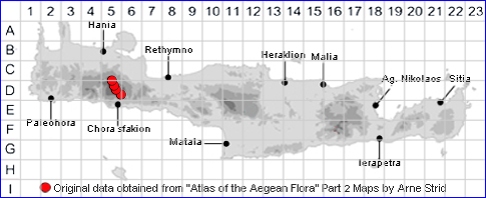
CYNOGLOSSUM SPHACIOTICUM
Family and Genus:- See- BORAGINACEAE
Common Names:- None
Homotypic Synonyms:- None
Meaning:- Cynoglossum (Gr) Hound's-tongue, a name used by the Greek
physician Dioscorides' to describe the rough texture of the leaf.
Sphacioticum (Gr) Damaged-looking, of gangrened appearance.
General description:- Woody-based perennial.
Stems:-
1) 5-15 cm, suberect, simple or branched above, hirsute.
Leaves:-
a) cauline, linear-lanceolate. sessile, hairy on both surfaces.
b) basal, oblanceolate, pilose on both sides and with ± deflexed hairs on the
margins, greyish-green.
Flowers:-
1) Cymes, simple or forked ebracteate.
2) Calyx-lobes, c. 3 mm, oblong, hirsute.
3) Corolla limb,) c. 5 mm, diam, deep blue to violet.
a) tube, broadly infundibuliform.
b) limb, as long as the tube or somewhat longer.
c) lobes glabrous.
d) scales, crescent-shaped.
4) Stamens, inserted in the middle of the tube.
Fruit:-
1) Nutlets, dorsal face 7 x 5.5 mm, ovate, convex, densely glochidiate, without a
differentiated border.
Key features:-
1) Corolla, 4-6 mm, without reticulate venation.
2) Perennial.
3) Corolla-scales, crescent-shaped.
Habitat:- Dry, rocky limestone slopes and screes, rock ledges 1800-2300 m.
Distribution:- A rare local endemic of the Lefka Ori.
.
Flowering time:- May-June.
Photos by:- Fotis Samaritakis & Lucia Cortopassi
Status:-
Conservation status (for threatened species): Rare (R) according to the
Red Data Book of Rare and Threatened Plants of Greece (1995) - Rare (R)
according to IUCN 1997
Protection status (for threatened species): Greek Presidential Decreev67/1981
SPECIES DESCRIPTION
